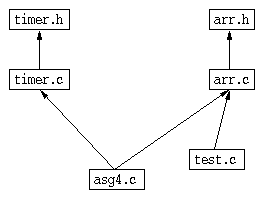(example Makefile for Assignment 4)
- The Makefile should exist in the same (seperate) directory
(
asg4for instance) as the files that need to be compiled and linked to generate the final executable program. - The files that make up a particular project are modules
which contain specific, ``stand-alone'' conceptual information.
- The Makefile's job is to check whether any changes have been
made to source code files, and then to compile each
file seperately (generating object files) before finally
assembling (linking) the entire collection of object files
into one executable program.
- Since there maybe many modules, once all the relevant information
is entered into the Makefile, to compile each seperately
all you need to do is type ``make''. Here is what you should
expect to see:
CC -c -I. -I/usr/include/ -I/usr/include/CC/ -o timer.o timer.c CC -c -I. -I/usr/include/ -I/usr/include/CC/ -o arr.o arr.c CC asg4.c timer.o arr.o -o asg4 CC test.c timer.o arr.o -o test
You can see above that the Makefile first seperately compiled the modulestimer.c, thenarr.c, then linkedtimer.o,arr.o, andasg4.cinto the executableasg4. The Makefile then re-usedtimer.oandarr.oto compile and link withtest.cto generate the executabletest. - In this particular example of the Makefile, the Makefile
expects the following files in the same directory:
Note that theFilename Contents arr.hArrayclass interface (that is, just the class definition)arr.cArrayclass implementation (that is, just the code for the class member functions)---needs to#include "arr.h"at toptimer.hTimerclass interfacetimer.cTimerclass implementation---needs to#include "timer.h"at toptest.cTester program to test array class (that is, just the main()routine to use and ``exercise'' the array class.asg4.cAssignment 4 program to test solution test.candasg4.cprograms need to#include "arr.h"andasg4.cneeds to also#include "timer.h". - Note in the paragraph above which files need to
#includefiles, and, in general, which files need which other files to function properly. This ``need'' is referred to as a dependency. For example, the program fileasg4.cuses, or depends on, the information inarr.handtimer.h, and (indirectly) also on the information inarr.candarr.c. These, in turn, also depend onarr.handtimer.h. This is shown in the graphic below. The Makefile is used to express these dependencies, and it uses this information to manage the compilation and linking of all these related files to generate the final executable programs.
